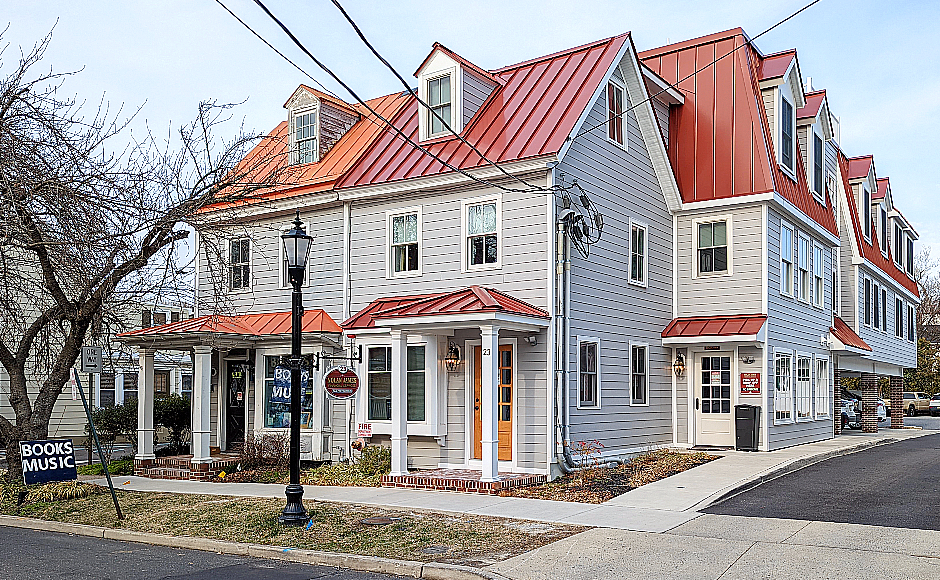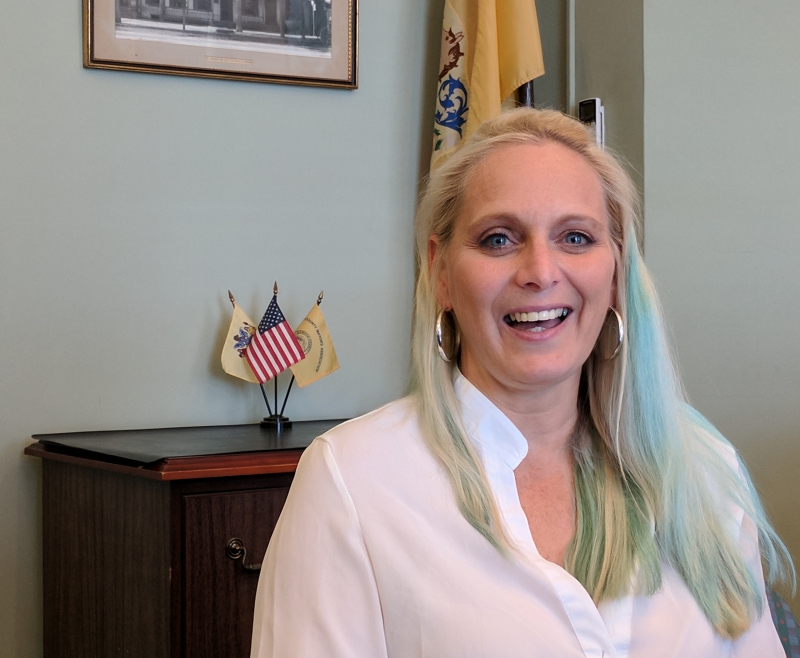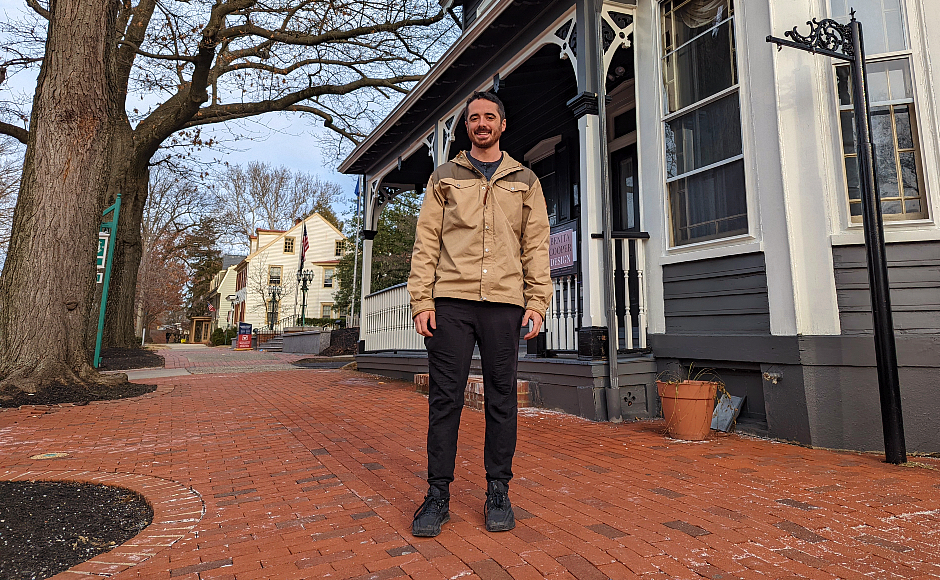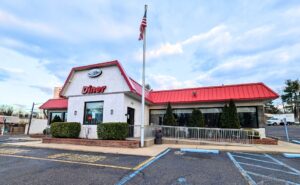Property Management Services Principal Tristan Sylk emphasizes adding residential units and business tenants who can sustain long-term operations in a walkable downtown environment. His strategy stands in contrast to that of prior landlords, who often emphasized short-term gains in a heated rental market.
By Matt Skoufalos | March 29, 2022
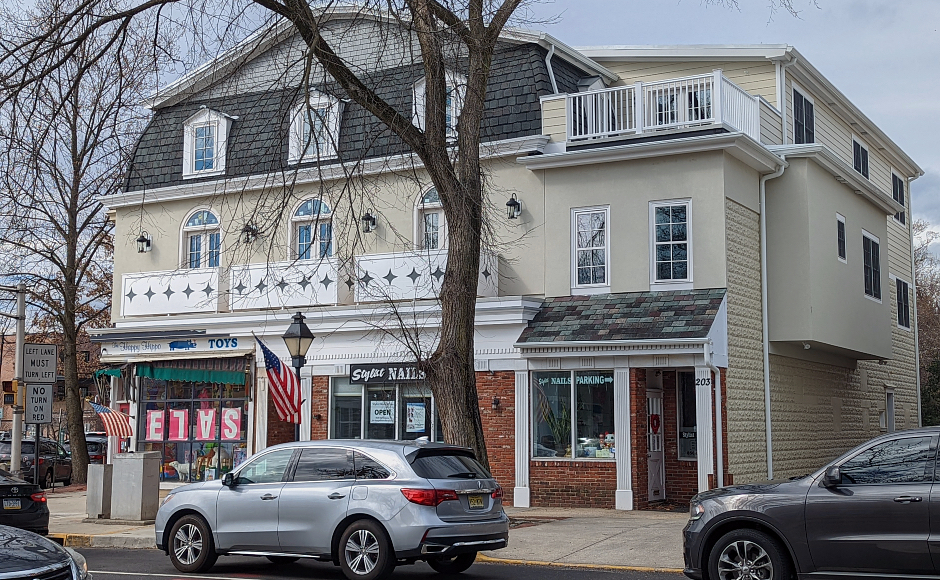
Property Management Services has overhauled residential units atop the Happy Hippo storefront at the corner of King’s Highway and Haddon Avenue. Credit: Matt Skoufalos.
What does it take to change the face of a community?
In most instances, the work that revives a slumping downtown business district, or overhauls a redevelopment site, can take multiple stakeholders a decade or longer to turn around.
The revival of downtown Collingswood, one of the hottest real estate markets in South Jersey, was years in the making.
Haddon Township similarly faced protracted legal battles and lengthy professional processes in activating disused brownfield properties along its central thoroughfare.
In the borough of Haddonfield, which, at a glance, has been humming along seemingly for years, the resurrection of its downtown commercial neighborhood has proven to be a generational reckoning.
Nearly a decade prior to the novel coronavirus (COVID-19) pandemic, the King’s Highway shopping district was feeling the rollover of half-a-century of change. Despite a revived interest in walkable, historic, Main Street communities that countered a 30-years-plus obsession with shopping malls, the business district was beset by departures of long-tenured commercial renters and a high turnover rate in other storefronts.
Business owners complained of high rents and limited foot traffic; others’ models were undercut by online shopping, or customer demographics that had aged out of their goods and services. Tenants’ concerns were further exacerbated by the concentration of storefront properties in the hands of a few landlords instead of individual owner-operators who might be better able to weather the changes.
Enter real estate investor Tristan Sylk, principal at the Hainesport-based Property Management Services (PMS).
In 2019, as reported by Philadelphia Business Journal, Sylk bought six properties from Haddonfield engineering firm Remington and Vernick and several more commercial and residential units from Buda-Levin Management L.P., whose partner, Gerald Levin, oversaw a significant number of commercial holdings in the borough.
Since then, PMS has continued to expand its Haddonfield portfolio. In all, the business now holds between 20 and 30 properties in downtown Haddonfield, the bulk of which are mixed-use units with addresses on Tanner Street, Mechanic Street, King’s Highway, and Haddon Avenue, all in the central business district.
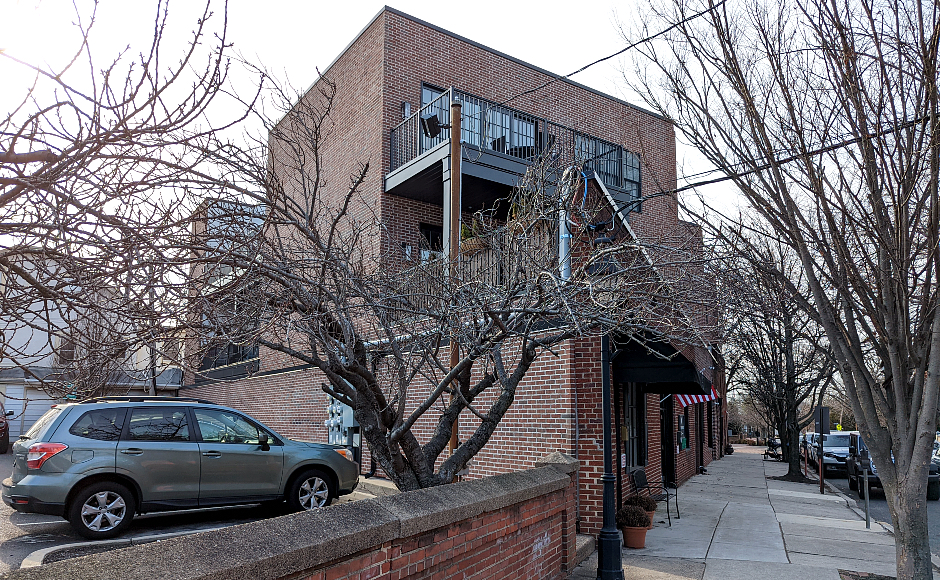
Redevelopment property on Haddon Avenue in Haddonfield. PMS added residential units above existing commercial storefronts. Credit: Matt Skoufalos.
Where the properties have included existing residential units, Sylk has worked to improve them; where they’ve been absent, he’s added more—11 so far—that are home to more than 100 tenants, a mix of residential, professional, and commercial renters.
Perhaps most compellingly to these tenants—and their neighbors—are Sylk’s stated goals not to flip them for short-term financial gain, but to manage them as a landlord who’s interested in cultivating a balanced mix of uses in the borough downtown.
Sylk prioritizes businesses that are a good long-term fit for the shopping district over those that are the most highly capitalized. He’s more interested in recruiting renters whose commercial concepts will contribute to the overall health of the business district than in signing deals just to plug holes in vacant storefronts.
“We don’t want to be those people who might be the reason for their failure,” Sylk said. “We have a very, very long-term view.
“We’re not doing this for the two-year or three-year plan,” he said. “We’re going to be here for 15 or 20 years, so we have a very strong financial incentive to do what’s right beyond just paying lip service.”
Asked to explain his recruiting process, Sylk simply said it centers on finding “good people.” To him, that’s more than being aligned with his moral code; it’s finding professionally minded folks whose businesses will fit within the broader neighborhood context, and helping them contribute to that landscape.
And it’s not some noblesse oblige that informs this perspective. Although Sylk very clearly values the opportunity to help small business owners bring their ideas to market, he describes the process of cultivating long-term renters as a sensible risk-mitigation strategy; one that allows him to sustain deeper relationships with tenants, and limits the amount of labor that comes with turning over a storefront every six months.
“If you have high leasing turnover, that’s a job,” Sylk said. “That’s two jobs, not only the leasing end, but the construction end, the fit-out end, and the downtime.
“This [approach] wasn’t ad hoc,” he said. “It was well thought-out, and designed around our end goal, which is great, long-term tenancy, which usually leads to happier people.
By building a brand around “longevity more than immediacy,” Sylk said his approach to infill redevelopment and retail recruitment is beginning to spread among peers of his age group in other generational Haddonfield real estate families like the Silvestris, Leonards, and Rhoadses.
“Our generation is not the older generation,” Sylk said.
“I think the older generation was very hard-nosed in business.
“Our generation is collaborative; wants to help each other do better,” he said.
“I think because of that, we’ve been able to do a little bit more a little bit quicker and a little bit easier.
“We treat our job as customer service more than as renting,” Sylk said.
“We strive to be infallible solely because you need to be that good. You need to treat people really, really well. Every quarter, we’ll go around and sit down with our tenants, [asking] what’s going well and what’s not going well.”
In addition to recruiting a good mix of tenants and supporting their long-term growth, Sylk said he’s also worked to “lean into what [the borough] wants” in partnering with business owners who fit the vision that local leaders have for the community.
“My whole thing is balance,” he said. “If you keep a strong eye on how things interact with each other, there’s always a bell curve in the middle where you can maximize revenue and value for your tenants overall.”
To Sylk, the blueprint for a successful Haddonfield mirrors that of small, mostly developed communities like Princeton, or New Hope, Pennsylvania; at its apogee, he believes the borough could mirror the success of vacation destinations like Savannah, Georgia, or Aspen, Colorado. By building livable spaces in walkable towns, he’s working not just to meet market demands, but to generate the foot traffic that helps small businesses survive in them.
“What we are in the process of doing is building density, and we’re doing the units in a way which is going to entice empty-nesters to sell their homes and maintain a residence in town with elevator access,” Sylk said.
“It’s about the walkability of wherever someone’s at; they want the sense of community,” he said. “You can’t really beat that when you compare Haddonfield to anything.”
With a background in historic and multifamily construction (his resume includes projects like Frankford Lofts in Fishtown, or the office-to-apartments conversion of 1201 Spruce Street in Philadelphia), Sylk understands the demands of preserving the look and feel of period architecture in a place like Haddonfield while creating spaces that appeal to 21st century renters.
He’s also quick to credit tight collaborations with Haddonfield architect Thomas Wagner, professionals in the borough government, and volunteers on its historic preservation committee, with helping him achieve those goals.
“We are in a historic town, so we’re very much working within the footprints of these historic buildings,” Sylk said. “We’re working within an envelope; we’re not creating an envelope.”
Put more simply, his motto distills to: “Fun is solving problems.”
Revitalizing the community
Haddonfield Borough Administrator Sharon McCullough believes Sylk’s approach reflects the mindset of a “newer, younger generation of landlords” who prioritize quality of life within the community—and their role in contributing to it—as much as how they benefit personally from renting there.
“What I like about Tristan is that he truly wants to figure out what’s best for the community, and work his business plan around that,” McCullough said.
“That opens up a wide variety of possibilities of a more sustainable nature.
“It makes me excited to see what we can accomplish with these new developers and landlords who are in town,” she said. “I think our downtown has always been a [point of] pride, but I think it can really be a shining star with the work of the landlords, the Partnership [for Haddonfield, its downtown business improvement district], and the borough.”
McCullough said Sylk’s efforts to facilitate a variety of uses in his projects—livable space for empty-nesters, business activities that invite out-of-town interest, and pedestrian-scale experiences—allow people to see Haddonfield in myriad lights. It gives her hope for harnessing that energy into something that can sustain the borough as it enters the next chapter in its history.
“When you have folks around all the time, it really revitalizes the community,” McCullough said. “It gives businesses a reason to stay open.
“I really think we’re at the precipice of being able to put information out, plan things, and take advantage of the folks that are downtown, and get a whole new sense of excitement for downtown,” she said.
“It’s hard to keep downtown communities like Haddonfield so they can survive. [Sylk] is looking at trying to find ways to create destinations, so it’s a mix of things; so that everyone in the downtown gets the value of that.”
‘He’s going to reset what’s possible’
Several of Sylk’s commercial tenants already foresee the added value that the developer has brought to their business concepts.
Tommy Alfinito, who’s opening up Wildfether Distilling in the historic Jennings House at 236 King’s Highway, which Sylk acquired from Reminton and Vernick, said that “he’s been a dream” to work with.
“He’s willing to look long-term, and work with you to figure out how to get you to be successful, which he knows in turn will pay dividends for him down the line,” Alfinito said.
“I think he comes in with an entrepreneurial outlook to an industry that doesn’t have it.
“Normally it’s about the raw numbers and maximizing your return,” said Alfinito, who has a background in finance. “He’s putting in businesses that he thinks are needed and are going to succeed.”
Michael Pasquarello, who will open the first New Jersey location for his successful Philadelphia eatery, Café Lift, at 142-144 King’s Highway, said Sylk’s approach “resonates with what’s necessary” for a property owner who commands the portfolio that he does.
“These properties change hands so frequently because rents are high; taxes are high,” Pasquarello said. “[Sylk] buys all this real estate up, and he’s going to reset what’s possible; to do the hard work to sort of control the whole landscape.”
Although Pasquarello said he’s always believed that a brunch-focused eatery like Café Lift would perform well in lots of communities, serving food in a high-rent district like Haddonfield without the benefit of a liquor license means bringing in consistent foot traffic throughout the week.
“[The choice] comes down to a business district, like Center City, where the rents are so high that you can’t pay those occupancy costs, or you end up in a walking town,” Pasquarello said.
“I wanted to open something up in the community to be a part of the community at that scale.”
Pasquarello also credited Sylk with having the foresight to consider a longer on-ramp for Café Lift to establish its brand within the broader context of downtown Haddonfield.
That his landlord continues to add new residential units to the area in addition to revitalizing its commercial buildings also helps contribute to that walkable downtown atmosphere by adding a customer install base.
“I think he’s going to be a big part of helping revitalize the strip,” Pasquarello said. “He’s making these apartments, and they look super-cool. People from the city see it and say, ‘I can get a parking spot? And brunch on a weekday?’ It took me more time to get from Fishtown to Center City than from my home in Haddonfield.”
“You’ve got to build it to make it happen,” he said. “You’ve got to pop people in places. Tristan’s doing the best thing he could possibly do.”
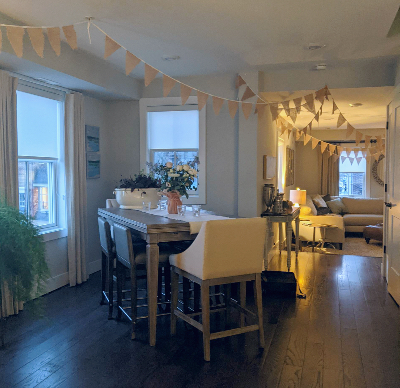
The Shea family was one of Sylk’s earliest apartment renters in Haddonfield. Credit: Matt Skoufalos.
‘We redefined ourselves’
Haddonfield resident Jean Shea, who was one of Sylk’s first tenants in a project on Tanner Street said her family initially had some trepidation about downsizing from their single-family home in the borough.
But the thought of moving into a smaller apartment appealed to them; particularly, cutting down on yard work, cleaning, and other maintenance.
“We wanted to gain time,” Shea said.
“What was so reassuring about it was Tristan was open to being a bit collaborative with us.
“Because we were able to talk with him early on and see the progression of the project, he allowed us some input into it, so when we moved in, it reflected our desires and needs and wants.”
After the family moved in, they found they transitioned as smoothly to apartment living as they did to the pace of the walkable downtown that became their new neighborhood. Shea said it’s easier than ever for her daughter to commute to their home via the PATCO Speedline, and she’s enjoyed exploring the business district in ways she hadn’t before.
“The freedom of just going out and walking in town is wonderful,” she said. “I cook less since I’m down here because I eat in town.
“We redefined ourselves, and discovered a new definition of what a neighbor is,” Shea said; “the professional finance guy who lives beneath us; the yoga gal who lives behind us. This is the fabric of what a community’s all about.”
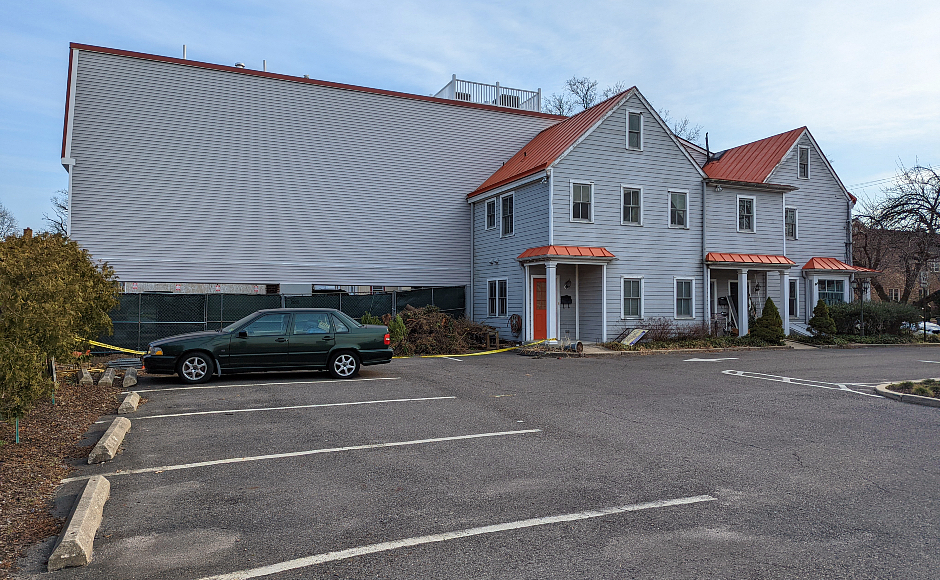
Side of a mixed-use property on Tanner Street where Property Management Services will add residential units. Credit: Matt Skoufalos.
Nowadays, when she walks King’s Highway, Shea said her thoughts wander to the residential units atop the storefronts.
She’s found herself thinking about who lives there, what those spaces look like, and what they might yet become.
“I would hope that if it’s not being updated, or reflecting the needs of today, that whoever owns it—or the town nudges whoever owns it—would look at the space as a way that those who want to remain in town can remain in town, or bring in new folks,” Shea said.
“There must be under-utilized space.”
If there is under-utilized space within the borough, Sylk seems to be the man to find it and put it to use. By virtue of the mere fact of his age—he’s still under 40—Sylk also commands a competitive advantage over other mid-scale redevelopers. Simply put, he expects to be around long enough to see the plans he’s laying blossom into fruition.
“We’ve made such a large investment in a large portion of the borough that there’s no single buyer we’d sell it to,” Sylk said. “If someone wants to be very cynical and say, ‘Why would you do what’s best for the town?,’ since we have a significant portion of the town, what’s best for us is best for the town, [and] short-term tenancy is not best for us.”

